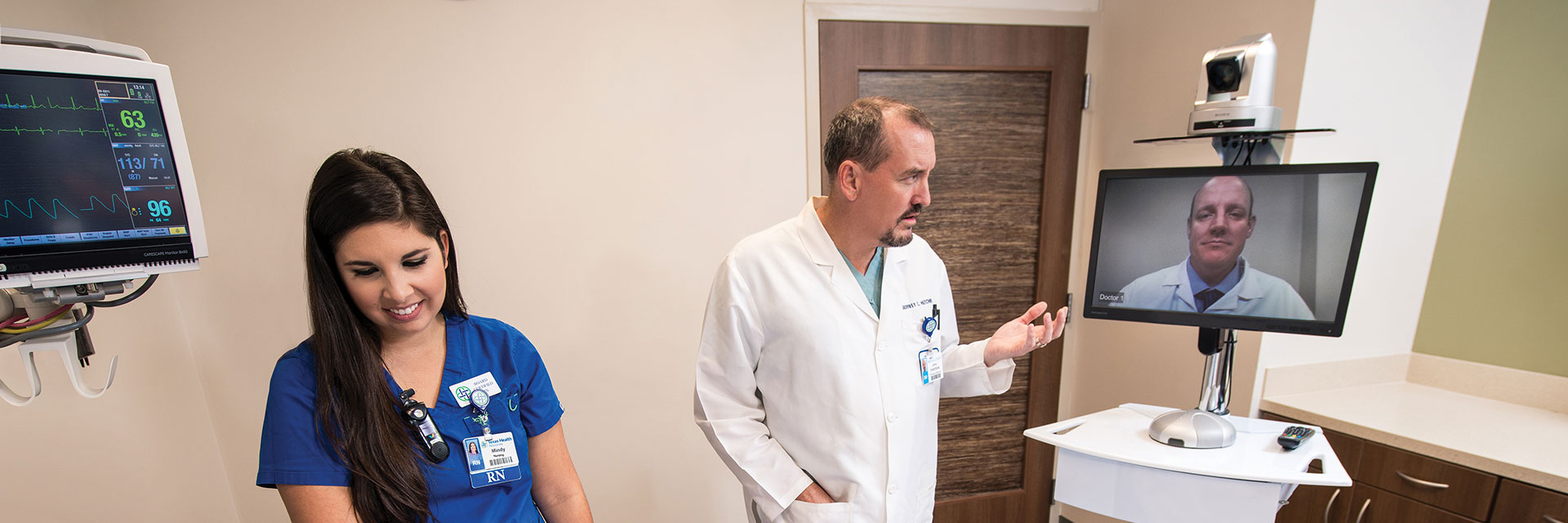If you or a loved one has experienced a stroke, you likely remember the symptoms well: numbness on one side of the body, vision and coordination problems, confusion and/or a severe headache. According to experts, time lost after a stroke is potential brain loss, so receiving care as soon as possible is crucial.
Physicians and staff at Texas Health Resources have launched a new telemedicine program that directly links neurologists on the medical staff at Texas Health Fort Worth to smaller Texas Health facilities around North Texas. This “telestroke” program provides patients in smaller surrounding hospitals access to real-time evaluations by a board-certified neurologist who can assess their condition and give nurses and doctors on the medical staff at the participating emergency room instructions for care, or set up a transfer to Texas Health Fort Worth for more immediate care.
Christie Hershey, stroke coordinator at Texas Health Harris Methodist Stephenville, says it’s crucial for a person suspected of having a stroke to go to the hospital as soon as possible.
“We always say that ‘time is brain,’ so seeking medical care for stroke is time-sensitive,” she says. “Getting the patient to a medical center quickly can make a huge impact on one’s life. The sooner a patient can be seen and evaluated, the more options for treatment are made available. According to the American Stroke Association, stroke is the number one cause of disability in the United States.”
Vinit Mehrotra, M.D., a neurologist and physician on the medical staff at Texas Health Fort Worth, says the new program was started when physicians saw a need for stroke care in a more timely manner.
“We take care of area stroke patients primarily in Fort Worth and used to get many of transfers from surrounding hospitals that didn’t have neurology coverage,” he explains. “We realized stroke patients needed earlier intervention because often they were being transferred without treatment. Under certain circumstances, we have brain–saving medication available to us (the clot-busting tPA) and if it is given early, it can save millions of neurons and can result in a better outcome.
The telestroke program allows patients in suburban and rural areas to receive advanced care from the comfort of their local hospital.
“When a patient comes to a smaller hospital with stroke-like symptoms, they are evaluated by the emergency room staff,” Mehrotra explains. “If the patient meets the criteria for the program, the stroke team contacts us in neurology and we discuss the situation. Then we log on to the technology system with a camera that allows us to see and talk to the patient, get the whole story, and then determine whether they are a candidate for tPA or other intervention.”
Hershey says the program allows patients to receive a higher level of care through the use of technology.
“While we are a rural community with a Support Level III Stroke Facility, the telestroke program allows us to partner with a Comprehensive Level I Stroke Facility via video conferencing technology,” Hershey explains. “Our staffs can interact, evaluate the patient together and then make decisions that best fit patients’ needs. These decisions can be made in a short window of time to determine whether a patient needs higher level of care at a comprehensive stroke center or can remain at their local hospital for continued stroke care. This process can eliminate the additional cost of a transfer. If a transfer is needed, it allows us to expedite the transfer to a higher level of care much more quickly, thus aiding in better patient outcomes.”
So far, Mehrotra says he and his colleagues on both sides of the camera have liked what they have seen from the telestroke program.
“We have cut down the time for stroke treatment, so the outcomes have improved,” he says. “This program gives the rural hospitals more confidence to care for these stroke patients. This program is something that is evolving in hospitals all over the country, so it will be interesting to see the next level. We may soon be able to use this technology to help more patients with other conditions, so this is likely just the beginning.”
Call 9-1-1 immediately if you or a loved one is experiencing stroke symptoms. For questions about the virtual stroke care program, find a Texas Health physician or call 1-877-THR-WELL for more information.

